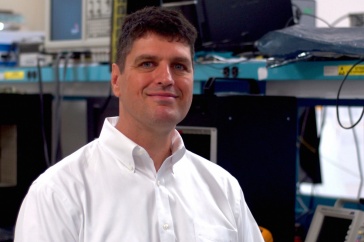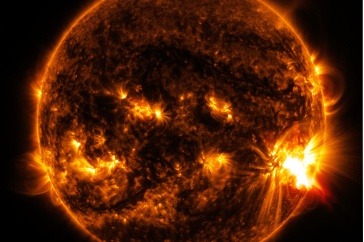
A new NASA-funded project will unlock the mystery of how turbulence heats space plasma - matter that makes up key elements in our universe. Illustration courtesy of NASA ARC.
NASA has selected UNH to lead a $250 million mission — the largest NASA contract in UNH’s history — that will improve our understanding of how the sun affects the space environment around Earth. UNH’s Space Science Center will oversee and coordinate all aspects of the mission, including preparing the spacecraft, designing onboard instruments and managing the entire team of scientists, researchers and contractors.
“We could not be prouder that UNH’s incredible team of scientists and engineers was selected for this NASA MIDEX space mission,” says Marian McCord, senior vice provost of research, economic engagement and outreach. “This is an exciting opportunity and a true testament to the high caliber of expertise and outstanding work being done at UNH’s Space Science Center.”

UNH’s HelioSwarm mission was selected by NASA in a competition including four other mission concepts. HelioSwarm will include the development of a suite, or swarm, of nine spacecraft to observe turbulence in the solar wind — charged particles released from the Sun — and the interplanetary magnetic field. One large spacecraft, known as the “hub,” and eight smaller spacecraft, called the “nodes,” will co-orbit to monitor the ever-changing turbulence in space to reveal for the first time how these variations look in three dimensions and how they evolve. The hub spacecraft will maintain radio contact with each small satellite and all radio contact between the swarm and Earth will be conducted through the hub spacecraft and the NASA Deep Space Network of spacecraft communication antennas. HelioSwarm’s novel implementation will unlock the mystery of how turbulence heats space plasma, which is matter that makes up key elements in the universe, like the sun, stars, solar wind and even the Earth’s upper atmosphere.
UNH will run the mission’s Science Operations Center, developing and delivering the central computer processors for each of the nine spacecraft and managing the entire science payload comprising a total of 28 individual instruments developed at partner institutions.
“Plasma turbulence is one of the fundamental, yet poorly understood, building blocks of how our sun affects the solar system, and, by extension, how stars influence their environments,” says Harlan Spence, director for the UNH Institute for the Study of Earth, Oceans, and Space and HelioSwarm principal investigator. “This mission leverages UNH’s incredible expertise and we look forward to leading efforts to help the world understand how the sun impacts our lives and the universe.”
The HelioSwarm mission will involve close to 25 UNH faculty, researchers, scientists and students as well as managers, engineers and technical staff. The team will work directly with a NASA field center, in this case NASA Ames Research Center in Sunnyvale, California.
Since the early 1990’s, NASA’s Explorers Program has provided several classes of flight opportunities to address NASA science objectives. The missions are designed to increase the number of flight opportunities in response to recommendations from the scientific community. The two mission categories include the MIDEX, or Medium Explorer, and SMEX, or Small Explorer, mission, with MIDEX receiving more funding. NASA provides an uncrewed commercial launch vehicle for the research teams to access space.
Watch: EOS director and HelioSwarm principal investigator Harlan Spence describes how HelioSwarm's nine spacecraft will reveal space turbulence for the first time ever.
-
Written By:
Robbin Ray ’82 | UNH Marketing | robbin.ray@unh.edu | 603-862-4864



















































